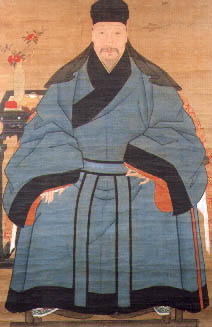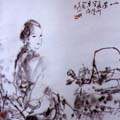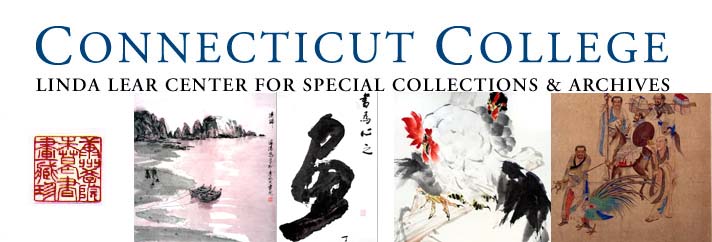A Brief History of Chinese Figure Painting
 When most westerners think of Chinese painting, they do not tend to think of figure painting. Landscapes of lofty hills or birds and flowers in the spring are familiar and resonate more readily with similar themes in western art. Those subjects are more culturally neutral, perhaps more universal, than figure paintings. Most of us need to feel a connection as individuals or representatives of a heritage with the people depicted in figure paintings in order to appreciate them fully.
When most westerners think of Chinese painting, they do not tend to think of figure painting. Landscapes of lofty hills or birds and flowers in the spring are familiar and resonate more readily with similar themes in western art. Those subjects are more culturally neutral, perhaps more universal, than figure paintings. Most of us need to feel a connection as individuals or representatives of a heritage with the people depicted in figure paintings in order to appreciate them fully.
Having acknowledged the relative unfamiliarity of figure painting to western viewers of Chinese art and so that we may more fully appreciate this unique genre, let us take a brief look at the history of Chinese figure painting.
Figure painting in China appeared in the Neolithic era, first on pottery, then on tiles, tomb and cave walls, and in family shrines. Landscape and Bird/flower painting came much later. The primary function of figure painting was transmission of moral and ethical principles. Paintings illustrated the Taoist search for nature, Buddhist reach for nirvana or Confucian counsel for filial piety. Temple scenes or quiet natural retreats provided settings for these illustrations. One of the earliest examples of Confucian teaching is "Admonition of Court Ladies" by Ku Kai-chih (344-405). This handscroll , now in the British Museum, is a series of courtyard scenes depicting young ladies learning about proper deportment. One of the inscriptions read, "People know how to improve their visage, but not how to improve their character." It accompanies carefully drawn figures, draperies folding and stretching to indicate the posture of each person.
Times change, social and historical events became primary reasons for figure painting. Tang Dynasty court painters such as Yen Li-pen (died in 673), who painted the "Thirteen Emperors" and Chang Hsian, "Ladies Weaving Newly Prepared Silk," are represented in the Boston Museum. Chou Fang's "Tuning the Flute and Drinking Tea" (second half of the 8th century) is another dignified, elegant illustration of the life of the powerful and privileged. On all these examples, colors and refined lines delineate facial expressions, body movement and gestures. "Tuning the Flute" is at the Palace Museum in Taiwan.
Figure painting lost its momentum with the rise of landscape painting toward the end of the Tang Dynasty. Academy painters and the literati considered landscape painting the height of achievement. Li Kung-lin (1040-1106 ) was one of the few scholars who continued Ku Kai-chih's tradition. He was a Confucian gentleman who venerated the past but used his heritage to meet the popular demands of his time. He was known for his paintings of horses and humans portrayed with dignity and spirit. Li created the Pai Miao style (pure line drawing) for figures. His technique has been widely favored by artists since. It uses fine lines and no shadows, merging almost indistinguishably with calligraphy, (see "Chinese Figure Painting" by Tom Lawton, FREER GALLERY OF ART.)
At the peak of Li's dominance in traditional figure painting in the twelfth and early thirteenth century a freshness entered. Chan (Zen) artists created a new style. Sudden inspiration and spontaneity were valued. Chan artists painted lohans, poets, monks and illustrated Chan stories with broad strokes, tremulous lines and dashing monochrome ink washes. "The Sixth Patriarch Tearing Up a Sutra", painted by Liang Kai (mid 13th century), portrays the bald sixth patriarch ripping a sutra to show that Chan believers do not need written words. The brushwork is impetuous and quick.. The patriarch is calling out in ecstasy and his message is certainly clear. Chan painting came and went quickly. Literati artists considered the style too undisciplined and unorthodox. However, this spontaneity and spirit have had a lasting influence and it has continued to impact artists ever since.
A revival of traditional figure painting after decades of decline developed during the Ming Dynasty. Chou Chen (c1500-1535 ), Chang Lu (c1490-1563) , and Tang Yin (1470-1523)were scholar-amateur artists who painted individual scholar/officials or ordinary people instead of groups of people as described in earlier periods. Literati artists were independent painters. To respond to the demands of a broader audience, professional artists appeared. Chiu Ying, a landscape artist (c1495-1552) was also especially skillful at painting beautiful women. In "Spring Morning in Han Palace," now in the Palace Museum in Taiwan, Chiu depicts dancing, playing, portrait painting and other daily activities in the beautiful palace (See "Possessing the Past" by Wen Fang and James Watt.) His techniques are almost exactly like those of the Tang artists we have mentioned, but faces are thinner, there is more variety and color in draperies, and backgrounds are more elaborate. Chiu had a number of followers. One of them was his daughter, Chiu Chu (see "Mother and Children" in our collection.) Chen Hung-shou (1598-1652) was a later artist whose painting kept the continuity of figure painting. His "Viewing a Painting" is also in this exhibit. In different ways these Ming artists played important roles in the restoration of classical painting.
In the Ching dynasty (1644-1911) figure painting continued but did not flourish. Literati and court artists only half-heartedly depicted the human figure. Some followed Chiu Ying's style to illustrate novels, but portrayed slim, listless women to meet the demand for commercial portraits. Court painters engaged in painting Emperors journeying to the south. Along the Grand Canal north of the Yangtzu River "the eight eccentrics" in Yang Chou were changing this direction. Huang Shen (1687-1768) used unorthodox brushwork which contrasted sharply with the detailed portrayals of figures current in his generation. One can safely say that these artists were playing with ink, expressing the spirit of subjects rather than careful, fastidious rendering. In the early years of this century artists in the Shanghai School created their own styles, reinterpreting eccentric figure painting.
After 1949 Socialist realism was promoted and the traditional literati forms were discouraged. Soldiers, workers, laboring women and children became a new didactic style. This style is still current, but people on the mainland are now free to choose among many styles. Currently the China Academy of Fine Arts in Hang Chou has undertaken to build the new Che School of Literati Figure Painting in order to keep the tradition alive and well. Wu Shan-ming's portrait of a lady and Tong Chen-kuo's "Chess Players" in this exhibit are examples of this trend. This exhibition shows many styles, delivering many different messages, all serving to keep memories of human history alive.
In conclusion I quote my friend Thomas Lawton who wrote "…….cumulative fusing of imagery, style and the written word lends Chinese figure painting an artistic and intellectual depth that is unique." How true!
--Charles Chu (1918-2008)
Curator and Professor Emeritus, Connecticut College
Please click on the linked images below to see some of the highlights of the collection together with explanatory text from Professor Chu. For an extensive selection of images in the collection, see the figure painting section in the Connecticut College Visual Resources Library gallery.
 |
 |
 |
 |
|
| Fu Hsiao-shih b. 1932 |
Wang Xi-jing b. 1946 |
Artist Unknown Ancestral Portrait |
Ch'en Hung-shou 1599 - 1652 |
|
 |
 |
 |
 |
|
| Wu Shan-ming b. 1941 |
Tong Zhen-guo b. 1950 |
Chiu Chu mid-16th Century |
Ku Lo 1763 - 1837? |
